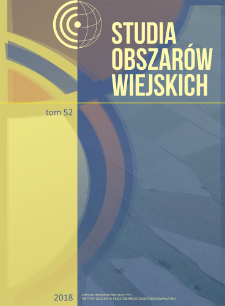- Search in all Repository
- Literature and maps
- Archeology
- Mills database
- Natural sciences
Advanced search
Advanced search
Advanced search
Advanced search
Advanced search

Object
Title: Zastosowanie miernika przewag konkurencyjnych J. Kaya do określania pozycji konkurencyjnej grup i organizacji producentów owoców i warzyw = Application of J. Kay’s competitive advantage index to determine the competitive position of fruit and vegetable producer groups and organizations
Creator:
Matuszczak, Anna : Autor ; Bieniek-Majka, Maryla : Autor
Date issued/created:
Resource type:
Subtitle:
Studia Obszarów Wiejskich = Rural Studies, t. 52
Publisher:
Place of publishing:
Description:
Type of object:
Abstract:
In order to identify the competitive position of the Kujawsko-pomorskie fruit and vegetable producer groups and organizations in relation to each other and deliberately selected representatives from voivodeships leading in the process of integrating this sector, an analytical scheme proposed by J. Kay was used, allowing for quantification of the competitive advantage in terms of results. The article presents the outcome of the research, which covered all groups and producer organizations as of the end of 2014 from the Kujawsko-pomorskie Voivodeship and one integrated representative with apples in his offer, from the Mazowieckie, Wielkopolskie and Lubelskie Voivodeships. In order to obtain the financial data published in the National Court Register, Info Veriti calculated a competitive advantage meter according to J. Kay. Additionally, by means of logistic regression, the equation for the probability of obtaining a positive competitive advantage index was established. The results of the research indicate that only 38% of the surveyed organizations achieved a positive value of the measure, which proves that group activities do not guarantee achieving a competitive advantage. Logistic regression evidenced that increasing the accomplishing a positive competitive advantage index results in obtaining certificates confirming the quality and safety of products introduced to the market as well as investments increasing fixed assets. On the other hand, a decrease in the chance may result in the growing number of members.
References:
1. Bieniek-Majka M., 2012, Grupy producentów owoców i warzyw w nowej perspektywie finansowej, Roczniki Naukowe SERiA, 11, 2, s. 7-10.
2. Chlebicka A., 2011, Czynniki wpływające na sukces grup producentów rolnych, Journal of Agribusiness and Rural Development, 4, 22, s. 31-39.
3. Kay J., 1996, Podstawy sukcesu firmy, PWE, Warszawa.
4. Małkowska M., 2004, Metody kwantyfikacji przewagi konkurencyjnej przedsiębiorstwa, [w:] E. Urbanowska-Sojkin, P. Banaszyk (red.), Współczesne metody zarządzania strategicznego przedsiębiorstwem, Zeszyty Naukowe Akademii Ekonomicznej w Poznaniu, 43, Wydawnictwo Akademii Ekonomicznej w Poznaniu, Poznań, s. 61-84.
5. Mroczek R., 2013, Wzrost produktywności i efektywności głównym wyzwaniem przedsiębiorstw przemysłu spożywczego, Materiały z referatu wygłoszonego w Jachrance 09-11.12.2013, IERiGŻ-PIB, Warszawa.
6. Skrzypek E., 2013, Uwarunkowania efektywności organizacyjnej w nowej ekonomii, Annales Universitatis Mariae Curie-Skłodowska Lublin - Polonia, 47, 1 H, s. 167-178.
7. Startegor, 2001, Zarzadzanie firmą. Strategie, struktury, decyzje, tożsamość, PWE, Warszawa.
8. Walczak W., 2010, Analiza czynników wpływających na konkurencyjność przedsiębiorstw, e-mentor nr 5/37, s. 5-12.
9. www.arimr.gov.pl
Relation:
Volume:
Start page:
End page:
Detailed Resource Type:
Format:
File size 0,3 MB ; application/octet-stream
Resource Identifier:
oai:rcin.org.pl:76847 ; 1642-4689 ; 10.7163/SOW.52.14
Source:
CBGiOŚ. IGiPZ PAN, call no. Cz.4488 ; CBGiOŚ. IGiPZ PAN, call no. Cz.4489 ; click here to follow the link
Language:
Language of abstract:
Rights:
Creative Commons Attribution BY 4.0 license
Terms of use:
Copyright-protected material. [CC BY 4.0] May be used within the scope specified in Creative Commons Attribution BY 4.0 license, full text available at: ; -
Digitizing institution:
Institute of Geography and Spatial Organization of the Polish Academy of Sciences
Original in:
Projects co-financed by:
Access:
Object collections:
- Digital Repository of Scientific Institutes > Partners' collections > Institute of Geography and Spatial Organization PAS (IGiPZ PAN) > Publications of IGiPZ PAN and employees
- Digital Repository of Scientific Institutes > Partners' collections > Institute of Geography and Spatial Organization PAS (IGiPZ PAN) > Library > Series/Journals/Periodics
- Digital Repository of Scientific Institutes > Literature > Books/Chapters
- Digital Repository of Scientific Institutes > Literature > Journals/Articles
Last modified:
Mar 25, 2021
In our library since:
Aug 1, 2019
Number of object content downloads / hits:
1161
All available object's versions:
https://rcin.org.pl./publication/99062
Show description in RDF format:
Show description in RDFa format:
Show description in OAI-PMH format:
Objects Similar
Matuszczak, Anna Bieniek-Majka, Maryla
Kołodziejczak, Anna Kossowski, Tomasz
Makieła, Zbigniew Sobala-Gwosdz, Agnieszka
Leśniak-Johann, Małgorzata Raczyk, Andrzej
Korcelli-Olejniczak, Ewa
Pawlak, Karolina Poczta, Walenty

 INSTYTUT ARCHEOLOGII I ETNOLOGII POLSKIEJ AKADEMII NAUK
INSTYTUT ARCHEOLOGII I ETNOLOGII POLSKIEJ AKADEMII NAUK
 INSTYTUT BADAŃ LITERACKICH POLSKIEJ AKADEMII NAUK
INSTYTUT BADAŃ LITERACKICH POLSKIEJ AKADEMII NAUK
 INSTYTUT BADAWCZY LEŚNICTWA
INSTYTUT BADAWCZY LEŚNICTWA
 INSTYTUT BIOLOGII DOŚWIADCZALNEJ IM. MARCELEGO NENCKIEGO POLSKIEJ AKADEMII NAUK
INSTYTUT BIOLOGII DOŚWIADCZALNEJ IM. MARCELEGO NENCKIEGO POLSKIEJ AKADEMII NAUK
 INSTYTUT BIOLOGII SSAKÓW POLSKIEJ AKADEMII NAUK
INSTYTUT BIOLOGII SSAKÓW POLSKIEJ AKADEMII NAUK
 INSTYTUT CHEMII FIZYCZNEJ PAN
INSTYTUT CHEMII FIZYCZNEJ PAN
 INSTYTUT CHEMII ORGANICZNEJ PAN
INSTYTUT CHEMII ORGANICZNEJ PAN
 INSTYTUT FILOZOFII I SOCJOLOGII PAN
INSTYTUT FILOZOFII I SOCJOLOGII PAN
 INSTYTUT GEOGRAFII I PRZESTRZENNEGO ZAGOSPODAROWANIA PAN
INSTYTUT GEOGRAFII I PRZESTRZENNEGO ZAGOSPODAROWANIA PAN
 INSTYTUT HISTORII im. TADEUSZA MANTEUFFLA POLSKIEJ AKADEMII NAUK
INSTYTUT HISTORII im. TADEUSZA MANTEUFFLA POLSKIEJ AKADEMII NAUK
 INSTYTUT JĘZYKA POLSKIEGO POLSKIEJ AKADEMII NAUK
INSTYTUT JĘZYKA POLSKIEGO POLSKIEJ AKADEMII NAUK
 INSTYTUT MATEMATYCZNY PAN
INSTYTUT MATEMATYCZNY PAN
 INSTYTUT MEDYCYNY DOŚWIADCZALNEJ I KLINICZNEJ IM.MIROSŁAWA MOSSAKOWSKIEGO POLSKIEJ AKADEMII NAUK
INSTYTUT MEDYCYNY DOŚWIADCZALNEJ I KLINICZNEJ IM.MIROSŁAWA MOSSAKOWSKIEGO POLSKIEJ AKADEMII NAUK
 INSTYTUT PODSTAWOWYCH PROBLEMÓW TECHNIKI PAN
INSTYTUT PODSTAWOWYCH PROBLEMÓW TECHNIKI PAN
 INSTYTUT SLAWISTYKI PAN
INSTYTUT SLAWISTYKI PAN
 SIEĆ BADAWCZA ŁUKASIEWICZ - INSTYTUT TECHNOLOGII MATERIAŁÓW ELEKTRONICZNYCH
SIEĆ BADAWCZA ŁUKASIEWICZ - INSTYTUT TECHNOLOGII MATERIAŁÓW ELEKTRONICZNYCH
 MUZEUM I INSTYTUT ZOOLOGII POLSKIEJ AKADEMII NAUK
MUZEUM I INSTYTUT ZOOLOGII POLSKIEJ AKADEMII NAUK
 INSTYTUT BADAŃ SYSTEMOWYCH PAN
INSTYTUT BADAŃ SYSTEMOWYCH PAN
 INSTYTUT BOTANIKI IM. WŁADYSŁAWA SZAFERA POLSKIEJ AKADEMII NAUK
INSTYTUT BOTANIKI IM. WŁADYSŁAWA SZAFERA POLSKIEJ AKADEMII NAUK




































